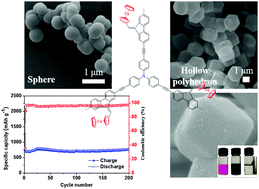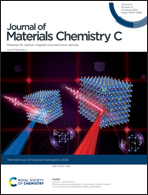Ferrocene-based hyperbranched polymers: a synthetic strategy for shape control and applications as electroactive materials and precursor-derived magnetic ceramics†
Abstract
The stable sandwich structure and the excellent redox activity of ferrocene make it a ubiquitous component in organometallic systems. The introduction of a ferrocenyl unit into a polymer skeleton provides a good avenue towards novel materials for various applications in redox batteries, enantioselective catalysis, optical and magnetic switches, etc. Herein, we report a strategic design and synthesis of new ferrocene-based hyperbranched polymers, and demonstrate promising methods for their morphology control as spheres by direct coupling reactions and hollow polyhedra by a templating approach. Furthermore, task-specific applications targeted for their respective architectures are investigated in lithium ion batteries (LIBs) and water treatment, respectively. The spherical polymer used as an electroactive anode in LIBs has a high capacity of 755.2 mA h g−1, stable chargeable performance of over 200 cycles and superior rate capability. For comparison, the hollow counterpart shows a sharp increase of the specific surface area in the precursor-derived magnetic ceramics from 417 to 1195 m2 g−1, and the as-made material exhibits great potential for the rapid removal of trace amounts of pollutants in water with magnetic reusability.

- This article is part of the themed collections: Journal of Materials Chemistry C Emerging Investigators and Journal of Materials Chemistry C HOT Papers


 Please wait while we load your content...
Please wait while we load your content...